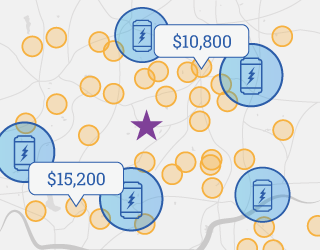(Updated November 2020)
California’s Self Generation Incentive Program (SGIP) is one of the first incentives for battery energy storage in the country. The program has been very successful, helping California to lead the nation in residential energy storage deployment. Recently, the program has received additional funding, with a slightly revised charter for how to use those funds. Below, we detail the adjustments to SGIP and how it will impact individual, residential solar + storage shoppers in California.
SGIP in a nutshell
As described in greater detail in our SGIP-specific article, SGIP provides incentive payments to customers in California that install energy storage systems. Specifically for residential consumers, SGIP provides an upfront rebate based on the amount of stored energy in the battery you install.
The incentive program is a tiered-block program, meaning that the level of incentives gradually decline over time as more batteries are installed in the state. This certainly leads to a first-mover opportunity to receive the highest level of rebates by being the first to act; however, given that the cost of energy storage has declined significantly over the last five years, California customers can be certain that SGIP continues to provide a sizeable rebate for installing energy storage.
For residential customers, SGIP is currently in Step 6, which provides a rebate of $200 per kilowatt-hour (kWh) of stored energy. According to California’s distributed generation statistics portal, the two most popular batteries in the state at present are the Tesla Powerwall 2 and the LG Chem RESU 10H. With usable energy capacities of 13.5 kWh and 10 kWh, respectively, Step 5 of SGIP would provide between a $2,000 and a $2,700 rebate for purchasing a new battery in California.
Funding levels increased
In 2018, California Senate Bill 700 authorized and directed the California Public Utilities Commission (CPUC) to extend and fund SGIP for an additional five years beyond its original expiration date of January 1, 2021. Over the next two years, the CPUC deliberated the amount of funds to direct towards the re-invigorated SGIP, with a final decision coming during January 2020.
Ultimately, the CPUC adopted a decision that approved the additional funding of SGIP by injecting a further $675 million into the program over the next five years. Combining that with carryover funds from the previous round of funding for SGIP means that there are now over $1 billion in SGIP incentives available in-state.
Adjustments to program budgets
However, given the increased threat from wildfires in California and the increasing prevalence of Public Safety Power Shutoffs (PSPS) throughout the state, the CPUC’s decision on the delivery of additional funds under SGIP is geared towards providing batteries to those customers who are most at risk of blackouts and power shutoffs.
In fact, nearly 60% of the current $1.056 billion program budget for SGIP is dedicated for “Equity Resiliency” projects. These projects are for people who meet one of a few specific qualifications: low-income customers, customers living in high fire risk areas, customers who experienced PSPS events on two or more distinct occasions, and critical facilities that provide services to these affected areas.
For customers who live in these areas and who are eligible for the Equity Resilience incentives, adding storage is not only a potential necessity of geography but now a financial no-brainer: the Equity Resilience incentive is at a level of $1,000 per kWh, meaning it should cover the entire installed cost of any residential energy storage system available on the market today.
How many batteries will be funded by the revised program?
At a $1,000 per kWh incentive rate for qualified Equity Resilience customers, the $613 million in incentives would fund between 45,000 and 60,000 batteries for disadvantaged customers and customers in high-fire risk areas.
The revised SGIP funding also sets aside $60 million for standard residential projects. If all of these funds were paid out at the current block rate of $200 per kWh, that would fund between 22,000 and 30,000 additional batteries, depending upon how much of that budget remains after dropping down to Step 6. Given that there are nearly 25,000 residential energy storage systems currently installed in California, the increased funding in SGIP will at a minimum increase overall battery deployment in the state fourfold.
Start saving immediately with solar + storage
Regardless of whether or not you live in California, you can start seeing savings by installing a solar or a solar plus storage system today. To receive free, custom quotes from local solar installation companies in your area, register for a free account on the EnergySage Marketplace.






